Our artists’ works encompass jewelry, wearables, accessories, art/decor, and functional items, geared for you, your spouse, and/or your children.
Jewelry

Seth Michael Studio: I choose inspiration for my jewelry from the unseen, but essential, life forms that make life possible across all biomes of Earth. I use precious recycled materials to hand craft the dynamic worlds of insects and pollinators. Creating these lifeforms as jewelry pieces fosters an intimate awareness of the interconnectedness of all lifeforms.

Lula Castillo: I create a collection of Eco-friendly accessories that are made with sustainable materials such nuts, rare beans and some other seeds collected in the Amazon rainforest. Parallel to this I developed a technique to work with recycled pieces of citrus peel, then I combine them with the seeds in order to create wearable pieces of art.

Ellen Cohen Design: I create sculptural art jewelry using ethically sourced and recycled/upcycled materials. All the silver I use is refined or reclaimed from old silver. Many of my stones are from old jewelry and others are ethically sourced. I have always been a “junker” purchasing what I can from second hand shops and collecting objects I have found or that have been gifted to me. I use old buttons, horns, rocks, shells, wood, and pottery shards. My cast silver sea grass cuff, part of my Earthscapes Collection, sends a big message – seagrass is a vital part of the marine ecosystem. My Naturals Collection uses stones and fossils as well as branches and pods cast directly from nature. All my collections pay homage to the Earth and invite the observer to take a closer look at all that they see.

Luana Coonen: Luana Coonen is committed to creating jewelry which is socially responsible and minimizes impact to the earth. She focuses on found natural specimens and when choosing to design with stones, she uses post-consumer diamonds (I.e., reclaimed, antique, recycled, or ‘harmony’ diamonds), traceable gemstones, or fair-mined stones from the USA. No insects or animals are harmed, killed, or injured to create this jewelry. She uses 100% recycled metals and FairTrade gold whenever possible. Green and eco-friendly products and techniques are utilized in the jewelry studio and packaging materials with an emphasis on low environmental impact.

Kate Cusack Zipper Jewelry: By working with a repurposed material, my artwork encourages the wearer to think twice about the world and to see beauty and potential in everything. I start with a zipper and I create innovative, elegant jewelry that celebrates imagination and promotes recycling. The zippers I use are discarded from fashion designers and given a new life in jewelry.

Lisa and Scott Cylinder: Our works center around the use, incorporation and deconstruction of repurposed materials and objects. Often representational and sometimes narrative, we address issues through the use of found objects from the 20th Century to discuss our contemporary world. The pieces that we make are imbued with an ironic sense of nostalgia while addressing issues of the man-made destruction of our environment.

Kate Dannenburg: I aim to bring my values of sustainability and responsibility to every aspect of my life and my art practice. I work almost exclusively with recycled or salvaged materials as well as buying tools and equipment second-hand and reusing packaging and shipping materials. In my studio I work to conserve energy, water, and materials, never letting anything go to waste.

Kristin De Santis Contemporary Jewelry: Most people look at my jewelry and ask “What is it made of? It’s so light!” I tell them “This is an old aluminum tube collected from scrap and surplus yards. I use a chop saw to cut the shapes to size and then fill them with hand-pigmented resins. Each colorful shape is handmade.

Griffith Evans: I create jewelry from trees decimated by drought. I harvest the trees in an orchard in northern New Mexico, the most water stressed state in the U.S. Climate change, in the form of rising temperatures and reduced snowpack, has provided the materials for my artistic practice. By repurposing dying trees, I celebrate their beauty while calling attention to their plight.
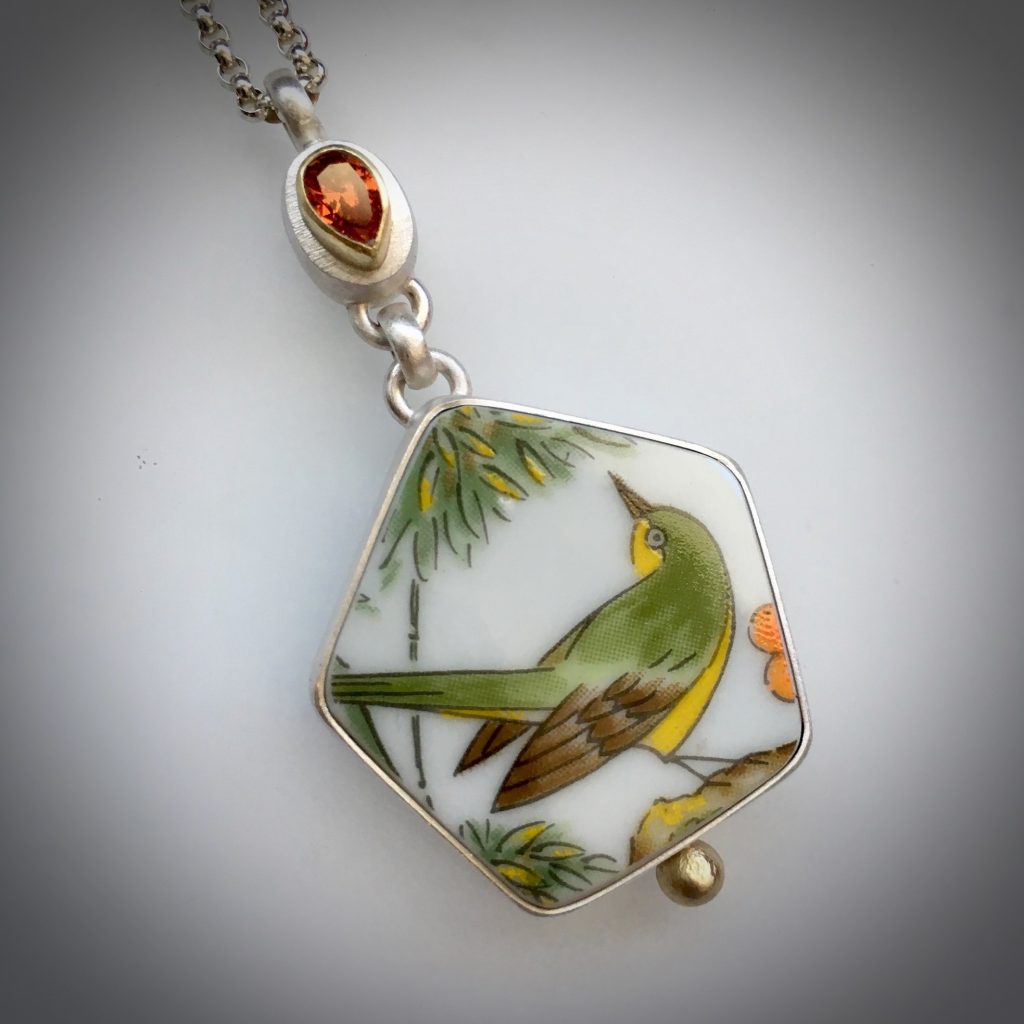
Amy Faust Eco-Friendly Fine Jewelry: In my jewelry work I aim for transformation of material, value, boldness and wear-ability. Reclaimed vintage glass bottles and jars, traffic lights, found pebbles and porcelain are cut in to defined shapes replacing the traditional use of gemstones. When I do use gemstones they are repurposed. In the porcelain, I look for imagery of farmland and birds, both fragile and loved parts of our environment . For the settings I use recycled sterling and fine silver that is hand-formed, forged and fabricated. I want each piece to be original, functional and ecologically friendly. No part of my work will damage the environment now or in the future and is made to last.

silverinjun:
I learned traditional Navajo silversmithing at a young age. I started exploring ideas by incorporating recycled and found objects into my work that were not often deemed “traditional” or met Native American juried art market guidelines. I believe that this started to create an awareness of cultural identity first and now hopefully an awareness of climate impact.

Christina Goodman: My miniature paintings to wear and my decorative objects feature birds, bees, plants and animals (some of them threatened or extinct) and are the focal point of my work. In a dangerously anthropocentric world, I hope to foster a connection with the small, beautiful and often vulnerable elements of the natural world.
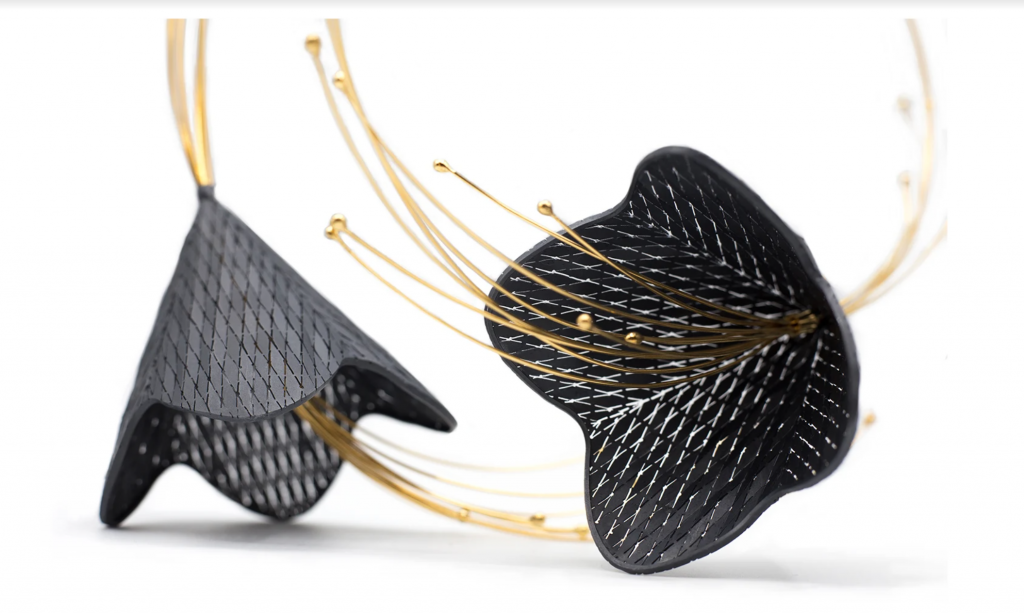
Xinia Guan: The theme of my jewelry is the power of the cyclic nature of time. Everything in nature is slowly growing and decaying, and then repeating. Each big jolt of our live is a slow accumulation of small, repetitive actions. Time is not passing, we are. And the imprint that we decide to leave in nature should be beautiful and poetic.

Andrea Haffner: My work invites people to embrace the small: to observe, appreciate, and cherish the abundant natural forms that grow in the world around us and might otherwise be overlooked. More than ever we need to honor and protect our environment. As the land surrounding my town was completely burned by fire three years ago, some of my work also addresses fire and regrowth in these times.
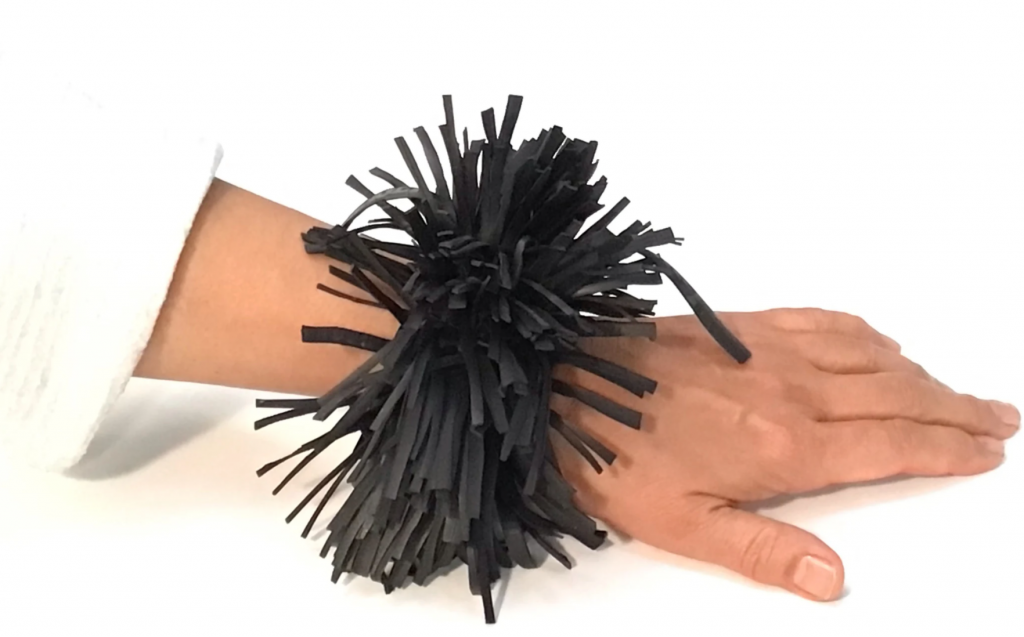
marirose: My upscaled pieces of jewelry are sustainable and GREEN while bringing a distinctive touch of beauty to the wearer. Recycling discarded materials such as rubber, plastic, and film through human skill creatively expresses the concern for preserving our environment. Art reflects our ever-changing culture, shapes our perception of the world around us, and even has the ability to alter society’s values.

Devin Johnson: My jewelry has 100% recycled content and my studio uses wind power for electricity. In each piece I strive to tell a story about humanity and and my artistic endeavors are environmentally friendly and sustainable. I use a variety of recycled, salvaged, antique, and found materials from all corners of life. Each material is a unique artifact; beautiful not only for their colors and textures, but also for their historical and technological significance. These characteristics, which are often very mechanical and industrial, are brought to the surface in my work, as I forge each into a finished piece.

Judith Kinghorn Designs: We make botanically inspired jewelry from recycled high karat gold and sterling silver.

Margaux Lange: My art jewelry reimagines and transforms the ubiquitous, mass-produced plastic Barbie doll. The Barbies are acquired secondhand, sourced via flea markets, garage sales, etc. I creatively repurpose these discarded dolls to live on as art. This is a key component of the conceptual basis for my work and my personal ethic to reduce, re-use and recycle.

Keith Lewis Studio: I carve my earrings from blocks of material made of recycled plastic water bottles. While they are just little earrings, they remind the wearer of the choice not to discard, but repurpose. I trust my use of raw minerals reminds us of how much beauty the Earth has to offer. Responsibility and gratitude, thoughtfulness and appreciation. I like those ingredients.

Holly Anne Mitchell: My jewelry consists of handmade recycled newspaper beads. Newspaper is an excellent alternative jewelry material because it reduces waste and encourages people to take a second look at everyday items which can be repurposed. I use a non-toxic adhesive, sealant, organically sourced cotton cord and beeswax which further reduce my jewelry’s impact on the environment.
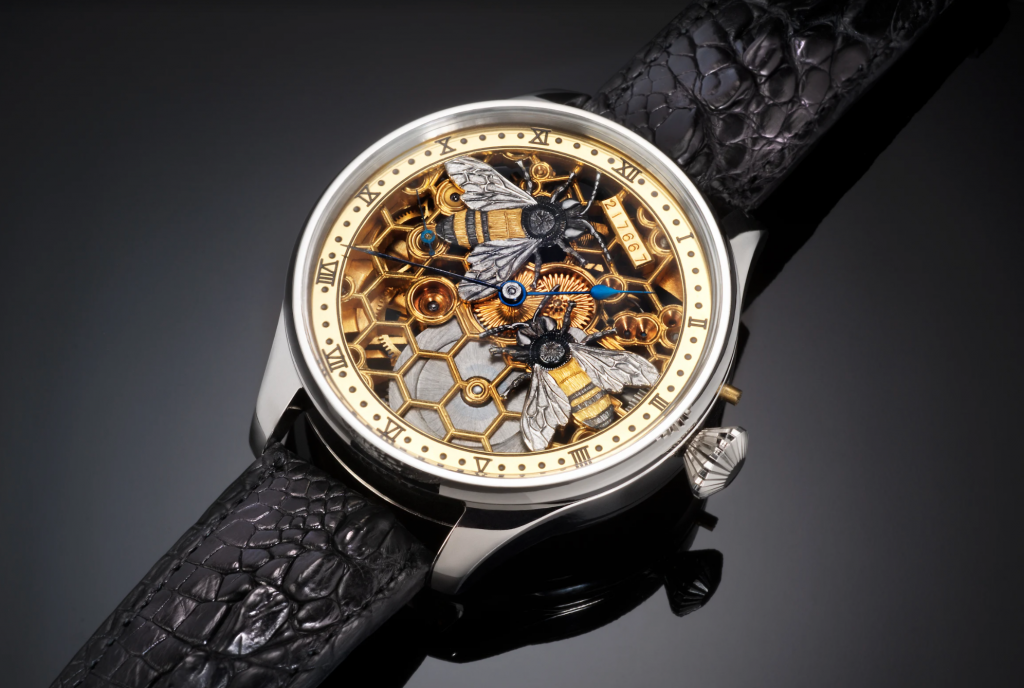
Carlos Montanaro / Rewind Jewelry: My jewelry is sustainable by utilizing found objects and fabrication to show that sustainability is as much about recycling as it is about innovation. Marrying the two things together, I create narrative jewelry with new applications of old material and show the value of something pre-existing and how it can be transformed into something modern and new.

Sarah Murphy: My work is about challenging the standard of perfection in jewelry making and the value of the materials being used. My process revolves around creating my own “gems” out of recycled plastic material that comes from my family’s steel cable manufacturing plant in Marion, Ohio. The discarded plastic material is dyed and manipulated to create one-of-a-kind pieces of jewelry.

Sara Owens: My jewelry, made primarily of used coffee filters, explores ideas around consumption. The term “used coffee filters” conjures images of the kitchen waste bin. By using them in my jewelry, I invite people to consider their waste stream, and to imagine it as a potential resource, a source of beauty and value. This view is the key to sustainability.
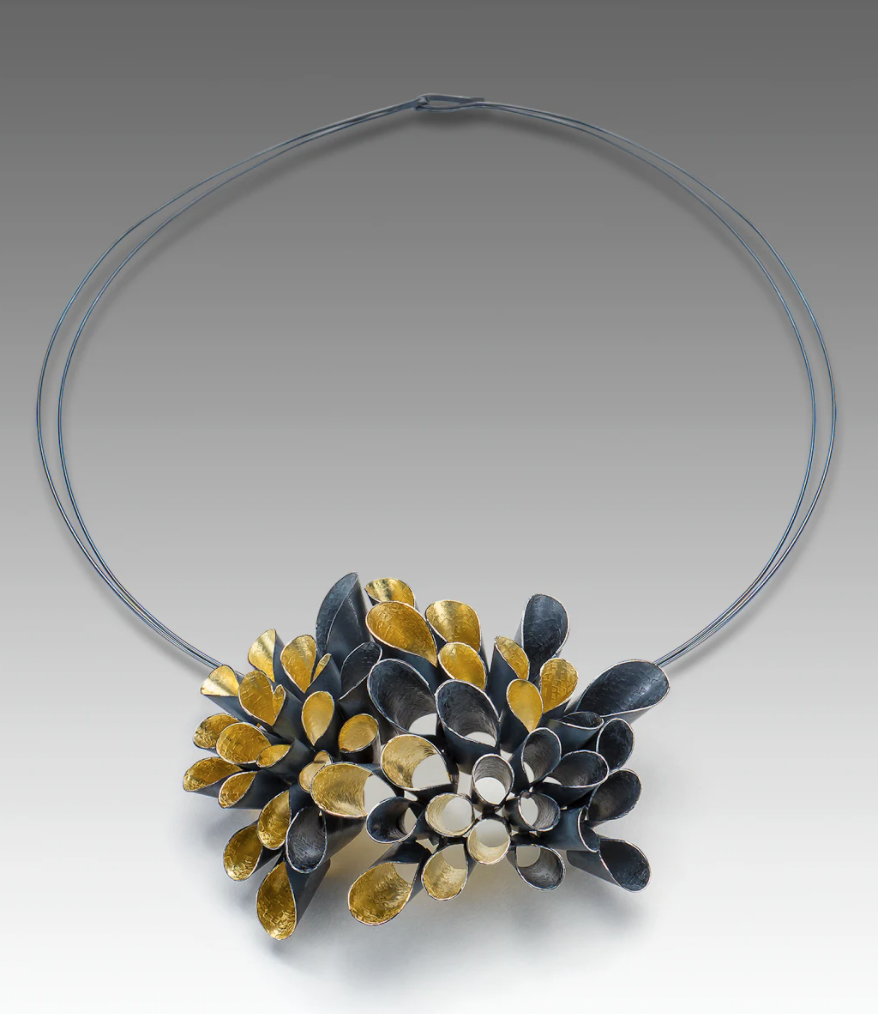
Jinbi Park: My pieces are inspired by nature’s organic structures especially those of the ocean, such as coral reefs. When I scuba dive I draw inspiration from the ocean’s beauty. With global warming, pollution, and overfishing reefs are dying all over the world so it’s my passion to create art with reef-like motifs so that I can share that beauty with others, some of whom will never see a living reef. I only use recycled metal and ethically, sustainably-mined gemstones as my work reflects the natural instead of taking away from it.

Buffalo Horn Artforms: Many of my jewelry designs feature Monarch and Swallowtail butterflies. In 2017, the World Wildlife Fund named me as one of six from around the country as “Monarch Heroes” for my work in making the Monarch jewelry and educating the public about the plight of the Monarchs. My art is also recycled, just as my Lakota ancestors used every part of the buffalo. Nothing goes to waste.

Gustav Reyes: I strive to create art with love and understand that this love is not a possession but a gift that must be shared. I try to give back to that love by making art, not by depleting the universe but by reshaping one of its greatest gifts – trees. Through the use of salvaged wood, all the energy, spirit, and history of the tree is worked to bring out that beauty. Art is a pure expression of a life lived without constraints. Each piece is created in a way that pays respect to that history, whether the use was mundane or sophisticated, whether I am working with a piece of concrete or wood from a musical instrument, a piece of furniture, or a precious family heirloom.
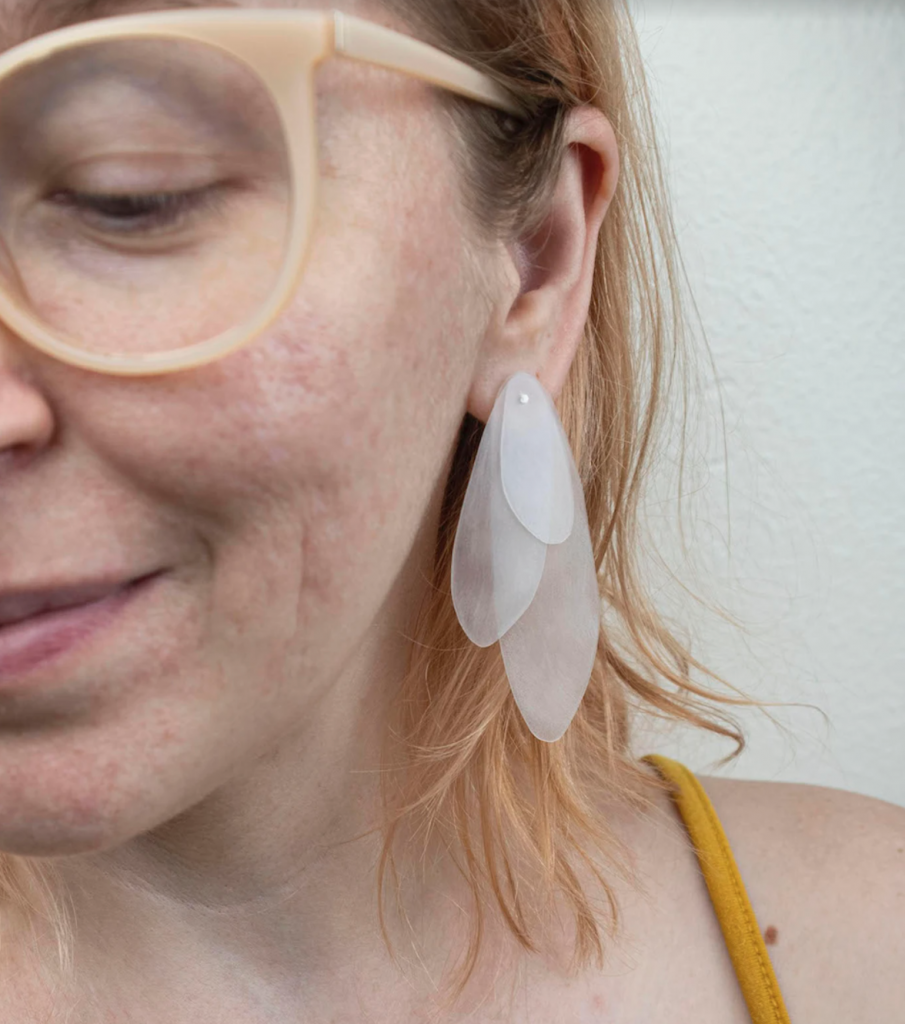
Charity Ridpath: For one year I collected all of the single-use plastic I used in order to better understand my own footprint. I then used this collection to make nature-inspired jewelry. By using plastic instead of traditional gems, I engage with the contradiction of single-use plastic; Though it’s only “useful” once, it has a lasting impact on our environment.
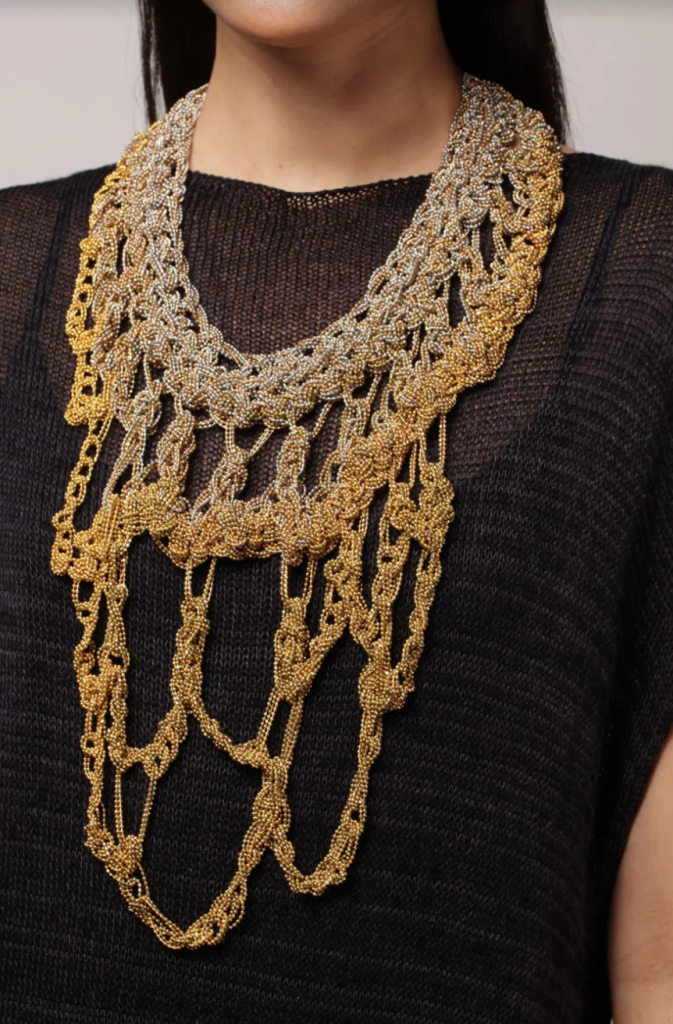
MPR Jewelry | Meghan Patrice Riley: By sourcing domestically from ballchain suppliers in NY and using upcycled parts from discarded jewelry manufacturing in my woven textile chain pieces, I am addressing waste reduction while also creating a high/low elegant, 1920’s inspired decadent elegance from these humble plumbing chain parts.

Kathleen Nowak Tucci: My jewelry is made with items that would normally be thrown away. I delight in recycling items destined for landfills and elevating those materials into high fashion jewelry and art.

Francesca Vitali: All my work is made using repurposed paper. One of the major ideas behind my work is indeed to give a second life to a humble material such as paper, and carry on its history trough the modification and transformation into a wearable object.
Wearables

Jeanne Akita / Illusions Lab: While creating my fiber art I focus on the sustainability of the process and materials using an ecological and cruelty-free approach. Felting is an ancient manual process that uses hand agitation and only a small amount of water and natural soap. I hand-select sustainable natural fibers as well as recycled natural fabrics. My goal is to create unique high fashion wearable art that is timeless and has a minimal environmental impact and a long life cycle unlike the fast fashion.
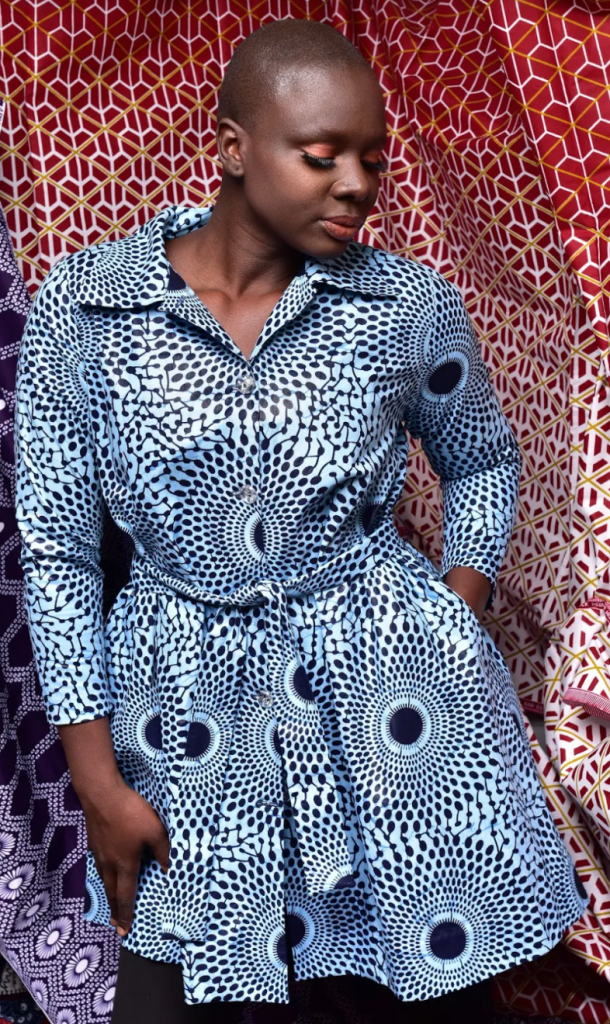
Queen Allotey-Pappoe: Our designs are made in small batches of mainly biodegradable natural fibers and salvaged fabric rendered in timeless silhouettes to encourage year round wear. We don’t follow fast-fashion trends and aim to reduce waste in our production process and in our customers’ closets. Our gowns are made with a zero waste approach using nearly all of the committed textile in that piece so as to reduce waste. Any scraps we have from our projects are redesigned into accessories.
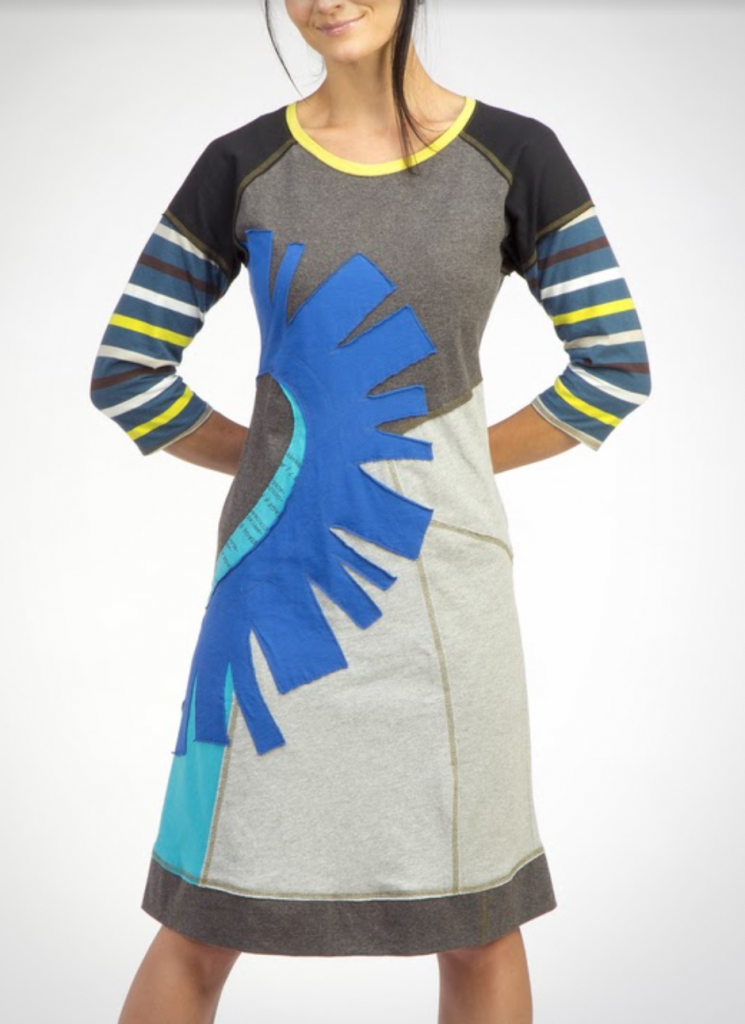
Elisabethan by Elisabeth Delehaunty: For almost 20 years, I have made my line of clothing entirely from post-consumer recycled & vintage fabrics; i.e. mostly cotton knits (t-shirts), button-down oxford shirts, cashmere & wool sweaters. My choice of raw materials preserves water & resources, as the fashion industry is resource intensive & highly polluting. Recycling is central to my work and I consistently highlight that aspect in talking about my clothing.

Fritelli and Lockwood: We weave cloth on looms using only foot and hand power and natural, sustainable fibers. Bamboo, grown under sustainable agricultural practices, is our fiber of choice but we also weave with wool from a regional spinning mill. Recently, we have been experimenting with fiber made from waste milk! It is certified green under the Oeko-Tex Standard 100 for international textiles. We’re very excited to debut our product line made from milk fiber at the Smithsonian show. We strive to be a zero-waste studio by incorporating our scraps as textural borders in our clothing. Many of our garments are designed with multiple fabrics so we can make efficient use of the bits and pieces left from other production.

Betsy Grob Giberson: After years of using chemical dyes, with the guidance of Hannah Regier, I finally started to use dye materials gathered from my garden, my yard & the woods behind my house. Everything I make is constructed with straight cuts, there is no waste. I use water and electricity with care & awareness.
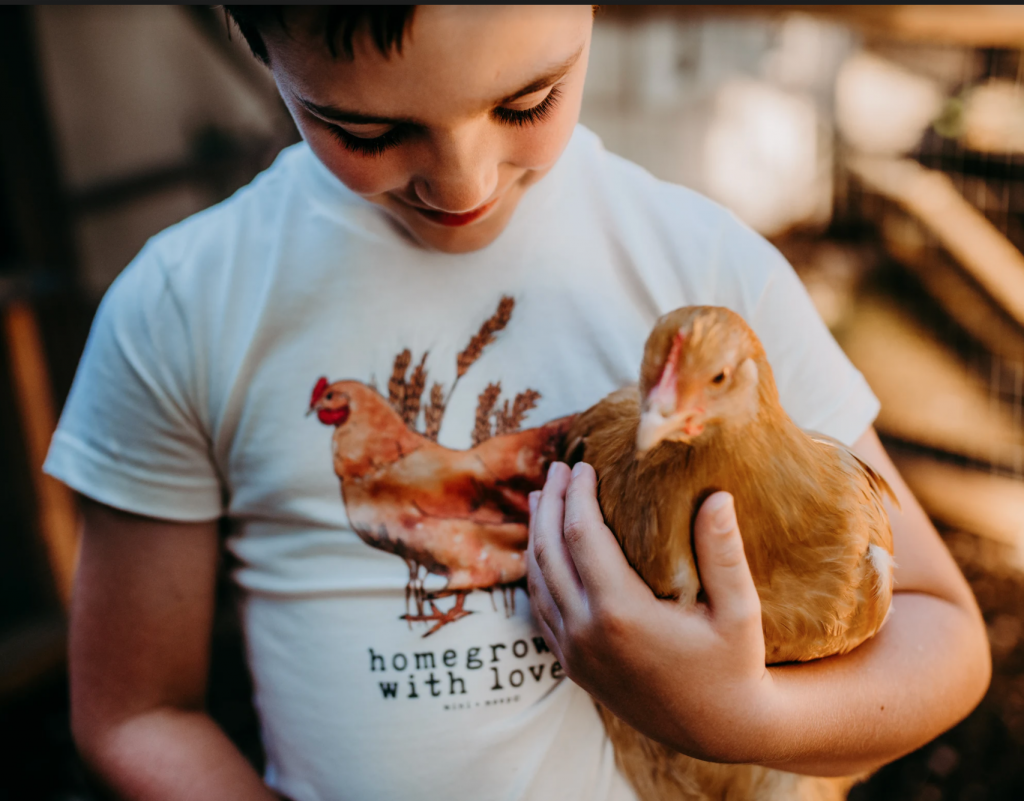
mini + meep: My children’s apparel is made with unbleached, organic cotton (no dyes) to reduce water pollution and no toxic chemicals are used during the finishing process. I hand paint all of the artwork with watercolor and ink. Every piece is created to inspire positivity, creativity and nature-based play in children. From where and how the cotton is grown, to the people who sew my one-of-a-kind products, I have gone above and beyond to support fair labor and ethical practices, protect the planet through hyper-local, sustainable manufacturing and give back to children in need. All of my shipping and packaging is made using 100% recycled, biodegradable paper.

Mary Jaeger: Repurposing studio textile fragments and garments transforms their lives while reducing domestic and third world landfills. Reconfiguring scrap fabrics inspired the PLEATED SILKS collection of dynamic, colorful wearables. The PERSONALIZED SHIRTS were stained, worn-out men’s cotton tailored shirts; deconstruction, dyes and stitches mutates them into one-of-a-kind, non-gender specific shirts/jackets that are fresh and desirable again by layering patterns and sustaining memories.

LaVerne Kemp: My work is inspired by my love of nature, particularly trees and how beautiful, interconnected, and majestic they are. Since childhood and throughout my artistic journey I’ve enjoyed sharing my creative visions of trees, using repurposed materials that I’ve over-dyed, spun, stitched, and woven while giving them new life. Repurposing a variety of found objects and rescued finds motivates my message of reinvestigating, re-engaging, and reconnecting with the world around us, both natural and human-made, with sensitivity and empathy. Through these practices, not only has my artwork allowed me to make beautiful sculptural wall pieces and items for the home but also wearable handwoven textiles such as shawls, scarves and ponchos using nature’s bold colors.

Knotzland designs wearable art using reclaimed materials. To date, Knotzland has diverted 3,427 pounds of fabric and offset 11,994 pounsa of CO2 from landfills. Knotzland trains and pays women with barriers to traditional employment to sew products that serve as a conversation piece about sustainability and the effects of traditional manufacturing on our planet and its role in climate change.

Sharon London Designs began our career in fiber art, recycling and upcycling vintage textiles and clothing in New York City. Our hand drawn vintage inspired designs are made from organic cotton and bamboo, machine knit, dyed, steam blocked, printed and sewn in small batches based in our solar powered studio. Zero waste, sustainable and made to last and enjoy for a lifetime.

Zoe Foat Naselaris / Foat Design: We offer a refreshing, eco-conscious alternative in women’s fashion. We’ve broken down the importance of buying sustainable, one-of-a-kind clothing from ethical companies into three simple reasons: it honors the Earth, it honors people, and it lasts longer. It’s important to know why stocking a closet with eco-friendly clothing designed and made by apparel artists using anything from organic cotton to thrift store finds–makes a difference to our environment.
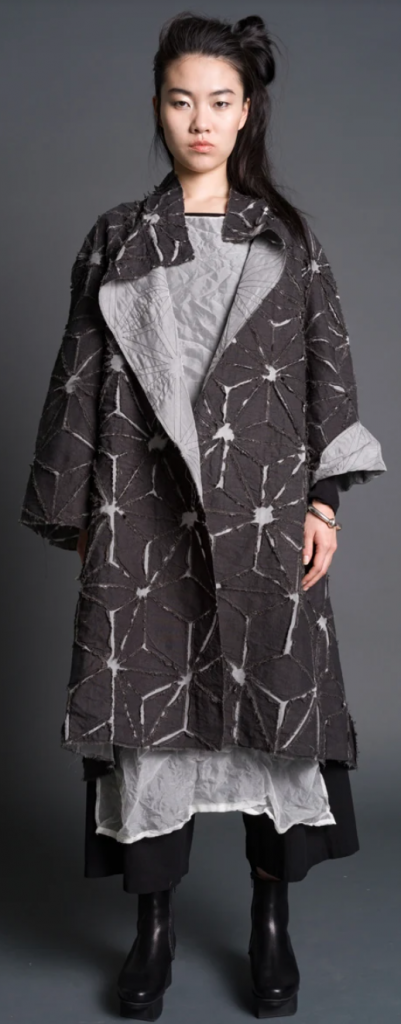
Amy Nguyen: Using age-old textile techniques with modern interpretation, we carefully consider our footprint in this small studio. We use naturally renewable fibers produced from wind-power, consciously source natural and manmade dyes, use low-water immersion dyeing techniques and use every scrap of linen in one-of-a-kind woven textiles. Making conscious choices directly affects my body, our bodies, earth body.

Oh Bessie!: Our “U.S Made” model eliminates reliance on fossil fuel-based international transportation. We use natural fibers, or sustainable fabrics made from post-consumer plastics for our apparel and printed with only water-based inks. We print our wall art in-house, and on-demand only, thereby reducing waste. A portion of sales of our “Under-the-Sea” growth chart is donated to the Ocean Conservancy.

Heidi Paul: Reclaim, Recycle, Redesign. The beauty of making something new from something discarded is where I find the challenge and inspiration for my work. The beauty of an original wearable is not only found on the body but also because less material went into the landfill. Through my work, and dialog, I hope to encourage others to look around them and see what they can reuse in their lives.

Hannah Regier: I grow or ethically forage all of my dyes and source raw fiber from local farms. Working with natural, local materials not only reduces the carbon footprint of my pieces, but also strengthens my immediate community and ecosystems. By connecting threads from the forests and fields that I love to your life, I aim to spread good nature and warmth. I see myself as being part of a wider virtuous circle, where your support allows me to continue the slow work of giving back to my surroundings with my attention towards ethical, life sustaining practices.

Lynn & K Meta Reintsema: We strive to make timeless designs with natural fibers that can be worn for many years. Minimal waste is an essential part of our creative process. Our goal is to utilize all of our materials for our designs and at times the cutaways have been our inspiration. For years we have been able to source most of our fibers from designer over runs. Occasionally we have had unusable remnants that we donate to a community craft organization for children.

Kim Schalk: Climate change and pollution impact every fiber of my moral being-from the fabrics I use (organic or recycled fabric), the practices that I adopt (repurposing scraps or refusing to use plastics) to creating economically sustainable art. And the later encourages my younger, very loyal, collectors/followers to help combat the “aging out” of craft shows. These reasons fuel my line (no pun intended) to which at its essence is the very opposite of fast fashion. Mine are pieces that will be with you forever.
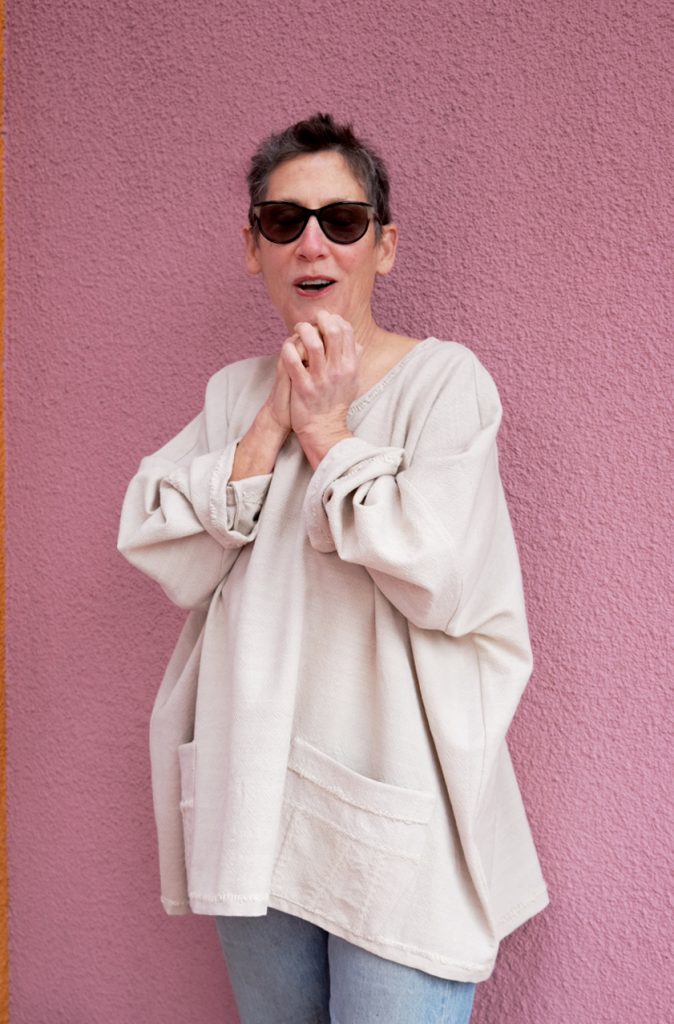
Carol Lee Shanks: Working with regionally produced materials is helping connect the dots between ranchers and artisans, raw products and fashion. These garments are made of Climate Beneficial Wool (fibershed.com/community-supported-cloth/) from sheep raised on the Bare Ranch. The cloth was woven by the Huston Textile Co. and my hand stitched surface patterns were created with yarns from our Fibershed (fibershed.org).

Liamolly: Each piece feels like plant based cashmere, super soft! They are made to order in our studio on a computerized knitting machine with little waste. They are washed in biodegradable soap with little water and hand finished in the rural Catskills.

ekologic by Kathleen Tesnakis: Saving terrain from over grazing by recycling cashmere, conserving water by using post – consumer materials thereby eliminating the scouring, washing and dye process, and reducing emission by recycling and ending dependance on new materials. Employing sustainable policies in our process by creating methods in which we can be zero waste in our ekologic circular design process.

Makwa Studio is a creative space focused on textiles, art and fashion. Much of the work is influenced by my Native heritage where I bring subtle cultural references to my patterns and design work. I strive to use eco friendly yarns, specializing in wool as it is both a renewable and biodegradable resource. Each item is designed and hand loomed in my studio in Minneapolis and is made to order, creating no excess goods. Stepping away from fast fashion I ensure high quality products that are made to last. As a Native business owner, I am interested in how Makwa not only contributes to the sustainability of a culture but also to the environment. Something that Indigenous Peoples from around the world have always cared for.

Kiki Verveniotis: To produce my clothing collection, I use deadstock fabric or linen finished in the United States according to strict environmental standards. I then repurpose remainders into one-of-a-kind pieces. I hand-crochet items from recycled yarn made from cutting room fabric scraps. I use new-old-stock vintage buttons whenever I can.
Accessories

ANA A: I create eyeglasses and purses from sustainable sources. The woods I use for making eyeglasses are sourced from sustainable operations in Colombia, certified by the Forest Stewardship Council and Fedemaderas (Colombia’s tree federation). Wood removed from discarded bark is repurposed and recycled to create unique and original pieces of art. For my purses I use Piñatex, a natural sustainability-sourced and cruelty-free alternative to leather made from the discarded leaves of the pineapple plant. Their use creates an additional income stream for farming communities. I am inspired by fashions from the past while keeping my eye on the future by interpreting classic designs with a modern flair.
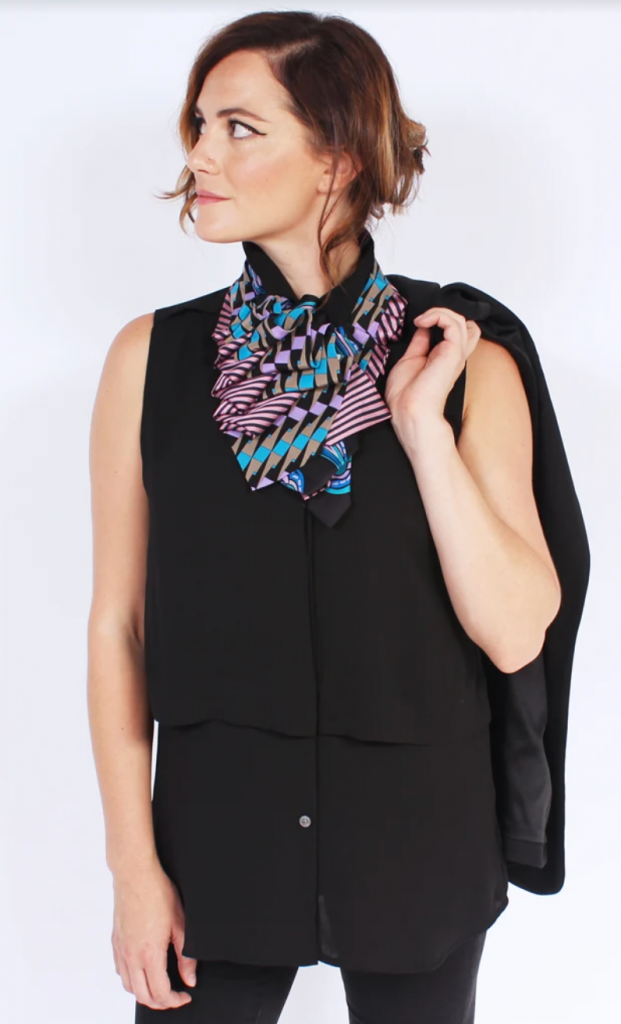
Lilian Asterfield by Nicole Deponte: I create wearable sculpture through the upcycling of vintage neckties. Each piece transforms one product into another, elevating it to a new something new, continuing our participation in and support of a circular economy.

Kristy Kun: For Craft Optimism, I created a new wearable flower exploring the intricate cupped-petal flowers of the Milkweed. Milkweed is the required host plants for monarch butterfly caterpillars (female monarchs lay their eggs on milkweeds) and their flowers provide nectar for bees, butterflies, and other beneficial insects. It is also an interesting and complex form to explore in handmade felt! It is my wish for these flowers to provide an opening for the wearer to Spread the Word about work that must be done in planting to support habitat and pollinators.

Jennifer McBrien: I am a fiber artist, who uses freehand-machine and hand embroidery with appliqué techniques on found, vintage, and certified organic fabrics to make my narrative wall hangings, decor pillows and handbags. I make ecological choices to keep my work sustainable with small batch, high quality and eco-friendly production. My work honors endangered and ignored birds and plants.
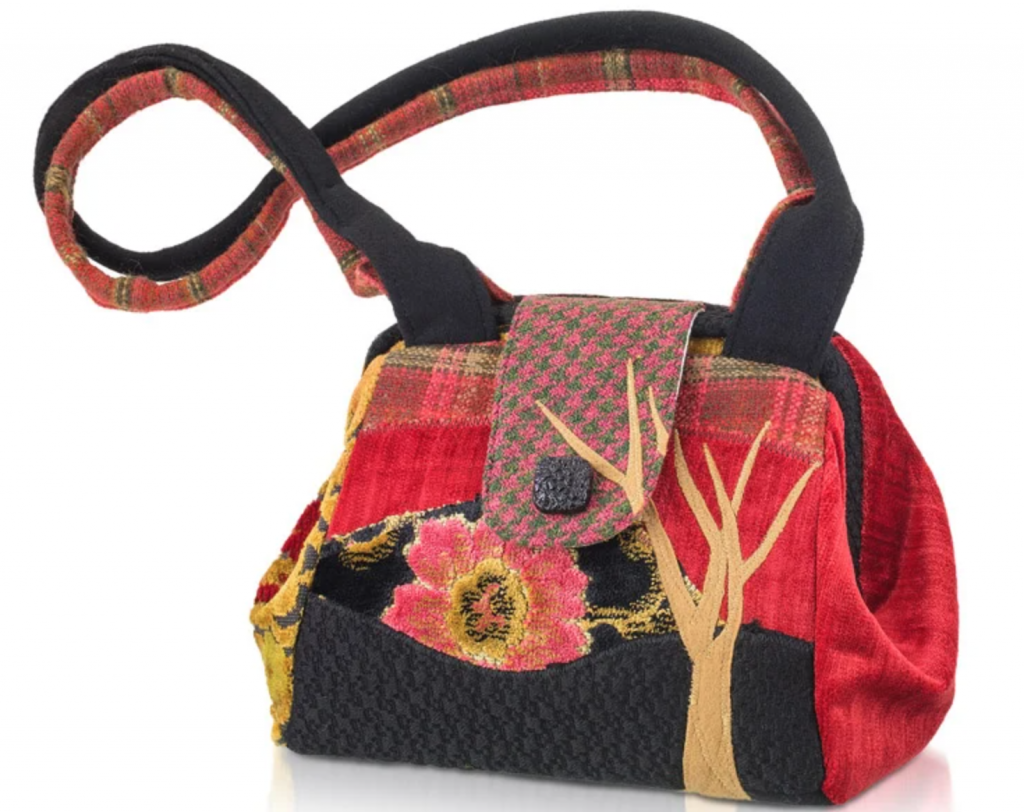
Jenae Michelle: My handbags are living examples of “fewer things, better things”. I use nearly 100% recycled materials which usually includes women’s wool coats from the 50’s and recycled tablecloths or drapery from the same era. Each bag is one of a kind. My work is a retreat from the uncertainty and chaos of modern life.

Olefson Art Opticals / Laurie Olefson: My quirky, deliberately imperfect eyeglass frames are hand -cut, -printed, -hammered, -grooved, -sanded and -polished from Mazzuchelli cellulose acetate, a renewable natural resource made from cotton fibers and wood flakes. All sunglasses boast professional discard lenses, (Currently there is no use for these.) keeping them from ending up in landfills around the world. I am proud that my final product combines both science and design.

Christina Roselle: Receiving interior design fabric and leather samples from furniture stores in the area, that would have otherwise been discarded, thrills me. Combining colors, patterns, and textures to make a bag is my passion. Because I have always disliked the habit of wasting, I purposely use what is already here and appreciate the character and uniqueness that it creates.

Alyssa Salomon: I screen print with eco-friendly, water-based inks and utilize non-toxic cyanotype photographic printing on plant-fiber materials. All fabrication is planned to minimize waste; offcuts are collected for use by a papermaker. Two series of totebags – Joy and Spinner – are made by printing on antique linen yardage and lined with vintage fabric leftovers donated by fellow textile workers.

Talouha by Christa Santa Maria: I work solely with vegetable tanned leather sourced from two of the last remaining vegetable tanneries in the United States. Vegetable tanned leather is produced by an ancient process that uses tannins from tree bark and other vegetable matter to transform hides into leather. The water used in this process can safely be sent back into the waterways without contaminating them. Vegetable tanned leather is compostable organic waste.

Kathleen Scranton / BeeZ by Scranton: My mission is to save every book I can from becoming landfill by creating book purses, eReader and laptop holders, wallets, journals, sketch books and memory boxes from the covers. I rebind the original book pages as a paperback so we can read them again and again. Books are national treasures and vintage printing a work of art.

BicycleTrash LLC: There is no away. Trash does not magically disappear from the face of the Earth when we discard it. My work makes bicycle waste (the parts that wear with normal use) a raw material. Instead of sending those parts to landfill, I make them valuable again, turning them into durable and wearable accessories for everyday use.
Art/Home

Laura Baring-Gould: I create resonate bronze objects that transform what is fragile and fleeting into talismans of enduring permanence. For years this work celebrated the tender stewardship of heirloom orchards and urban gardens, with fruits and seeds caste in recycled metal. New work now mourns what will be lost as I painstakingly recreate and cast the nesting structures of birds affected by climate change and habitat disruption.
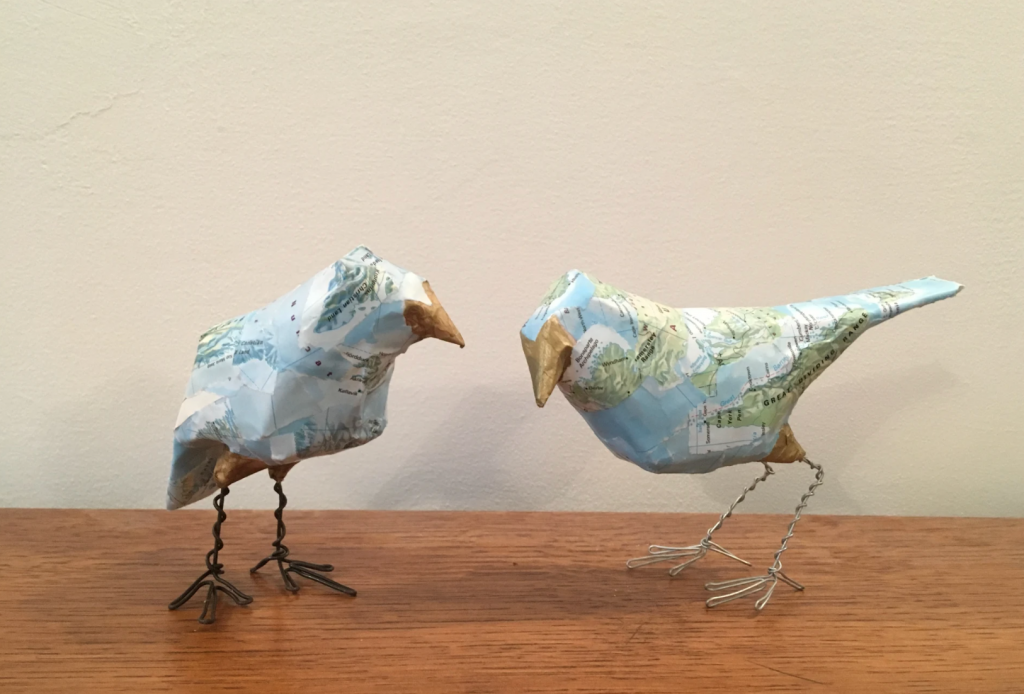
Jessica Beels: My work is made entirely from reused human-made and foraged natural materials. Each piece includes a list of materials reused, encouraging viewers to creatively reduce the waste they produce. The birds are intended to spur conversations about our relationship to the world we live in, what we keep or discard, and why.
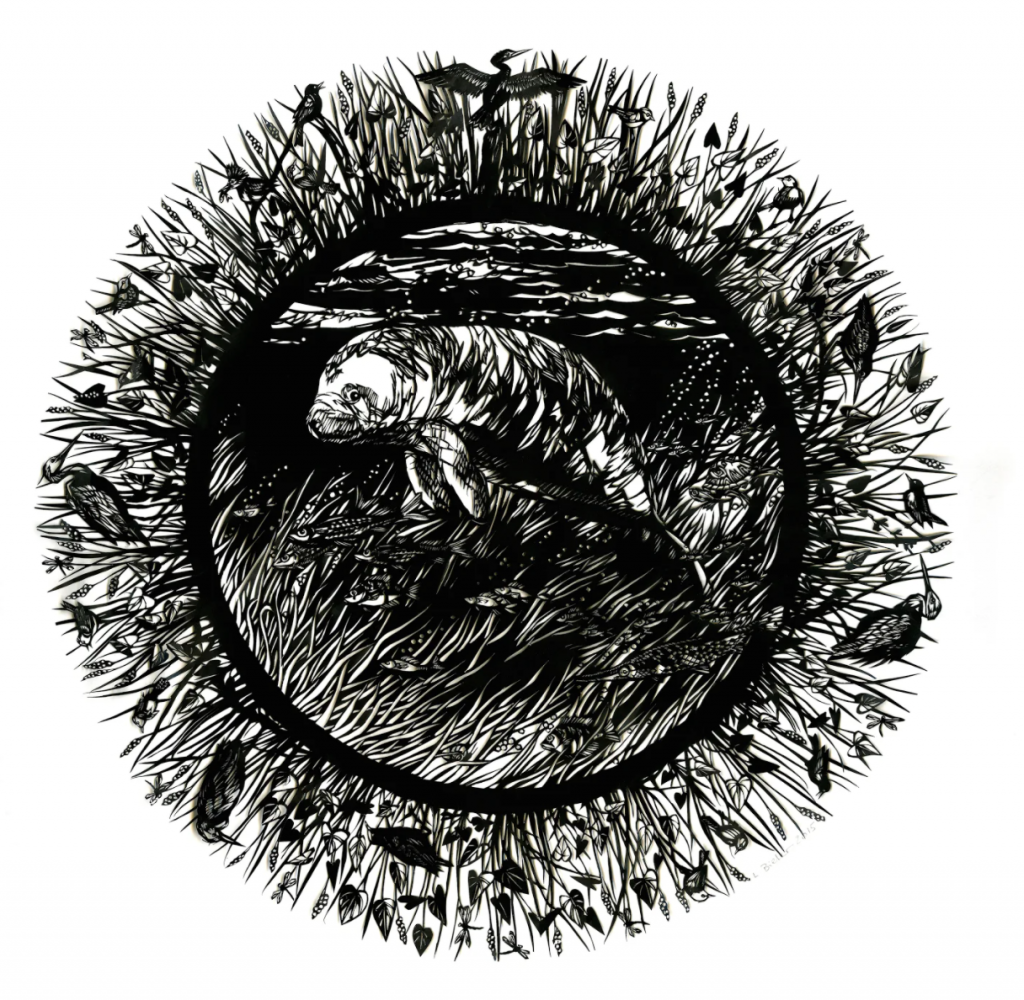
Lucrezia Bieler: The material and production process of my artwork (paper cut with scissors) reflects the delicacy and fragility of nature. Everything in nature is interconnected and interwoven. My work discusses these interactions in the environment, the eternal flow of life, endangered animals and their ecosystem, the impact of climate change, and importance of nature conservation to protect our planet.
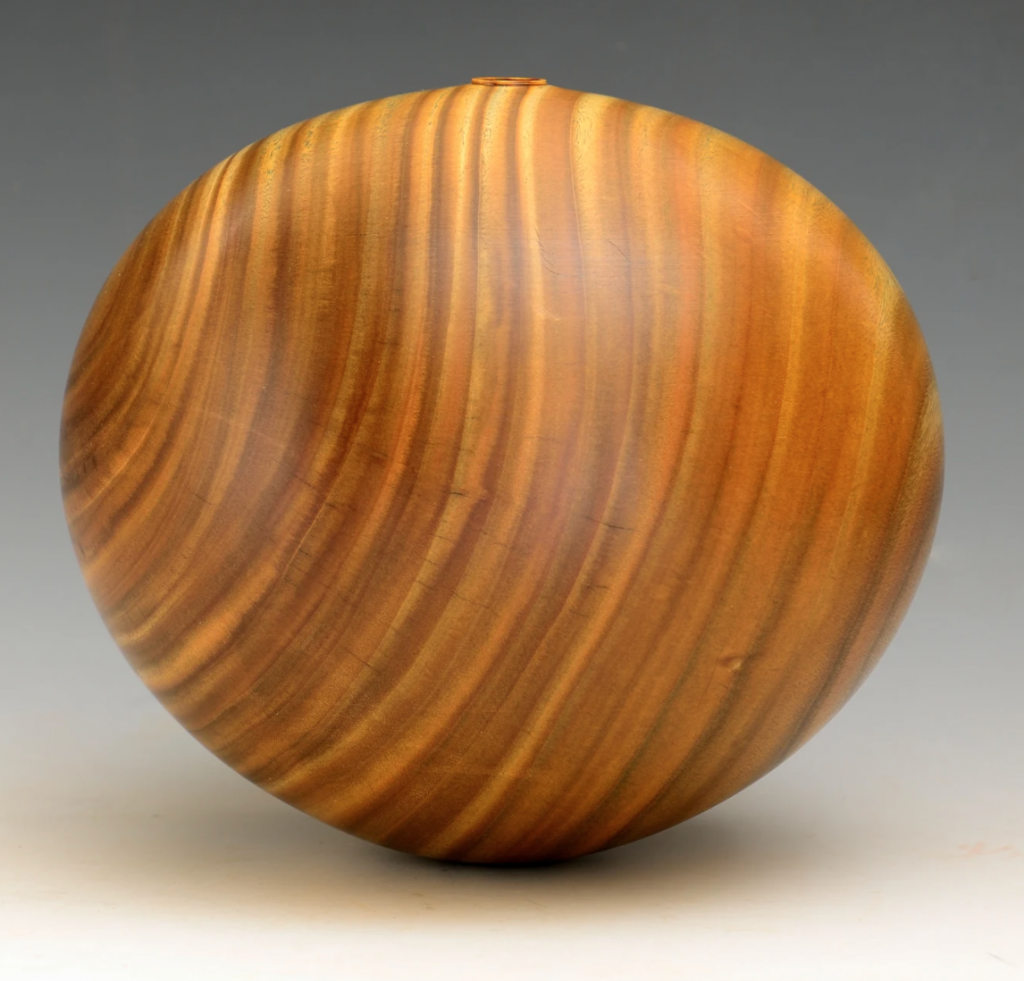
Gordon Browning: I use salvaged timber. The Northern hardwoods, Black Cherry, White Ash, Spalted Maple, all come from local deadfalls and logging culls. Caribbean wood–Cuban Mahogany, Verawood– is hurricane salvage from south Florida. The Padauk and Wenge are pulled from a sawmill burn pile in Gabon, Africa. My wood and my work tell a story of salvage and rehabilitation.
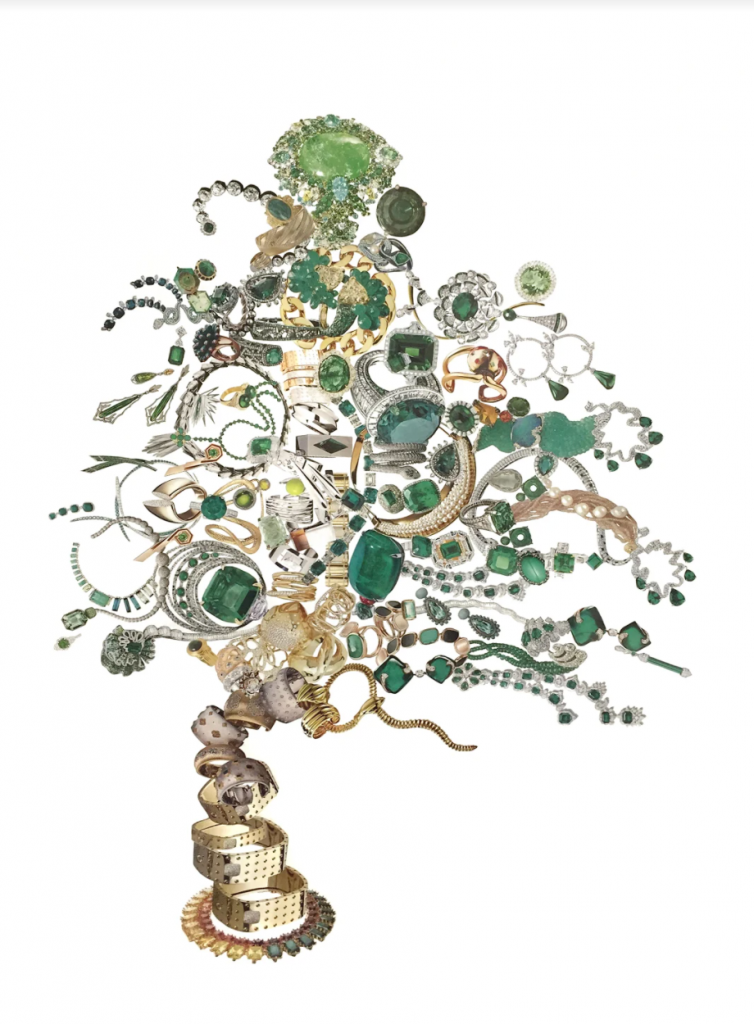
Leila Cartier: I am from Virginia’s Appalachian Mountains – once considered the heart of the coal industry and isolated by vast expanses of nature. Recent collage work is constructed using hand-cut images of jewelry found in magazines and adhered to paper made from stone. The result suggests a disparity between the expectation of permanence and value versus fragility and worthlessness.

Jiyoung Chung: My works are about the relationships surrounding nature, human and God and what is happening now – a broken, rejected, and forgotten understanding of these fundamental connections. We need to bring back essential order in these to seek what we lost (harmony and beauty) and to balance the world that we are living in. My main source material is paper made from mulberry tree branches, a tree that needs frequent prunning. So pruned branches are recycled to make paper while saving carbon-absorbing trees from logging.

Oh Bessie!: Our “U.S Made” model eliminates reliance on fossil fuel-based international transportation. We use natural fibers, or sustainable fabrics made from post-consumer plastics for our apparel and printed with only water-based inks. We print our wall art in-house, and on-demand only, thereby reducing waste. A portion of sales of our “Under-the-Sea” growth chart is donated to the Ocean Conservancy.

Studio Herron’s collection of hand dyed and woven sculptural vessels are objets d’art that emphasize form and explore ideas of use and decoration through the language of basketry. Using ancient lo-tek handweaving and sustainable and regenerative materials harvested from the land, we honor mythologies and traditions. Our textile work uses 100% material traceable down to the seed from the farm it was grown on in Virginia. Our blankets are produced in small batches using a conservative bottom-up grey water discharge methodology for material dyeing and processing. We believe in keeping ancient craft methodologies alive while also finding new language and modes of sustainable production– in essence, looking backward to find an informed way forward.

Liz Collins Studio: Selvedge loom waste is a fringe-like material that is a byproduct of the industrial weaving process. This material is generated in abundance at weaving mills worldwide, and is often treated as waste, going to landfills. My pieces exemplify the upcycling possibilities of this unique yet ubiquitous material by presenting pieces that are beautiful, stylish, and artisanal. I hope they encourage others to experiment and explore new approaches to keeping reusable products out of our landfills.

Kate Dannenburg: I aim to bring my values of sustainability and responsibility to every aspect of my life and my art practice. I work almost exclusively with recycled or salvaged materials as well as buying tools and equipment second-hand and reusing packaging and shipping materials. In my studio I work to conserve energy, water, and materials, never letting anything go to waste.
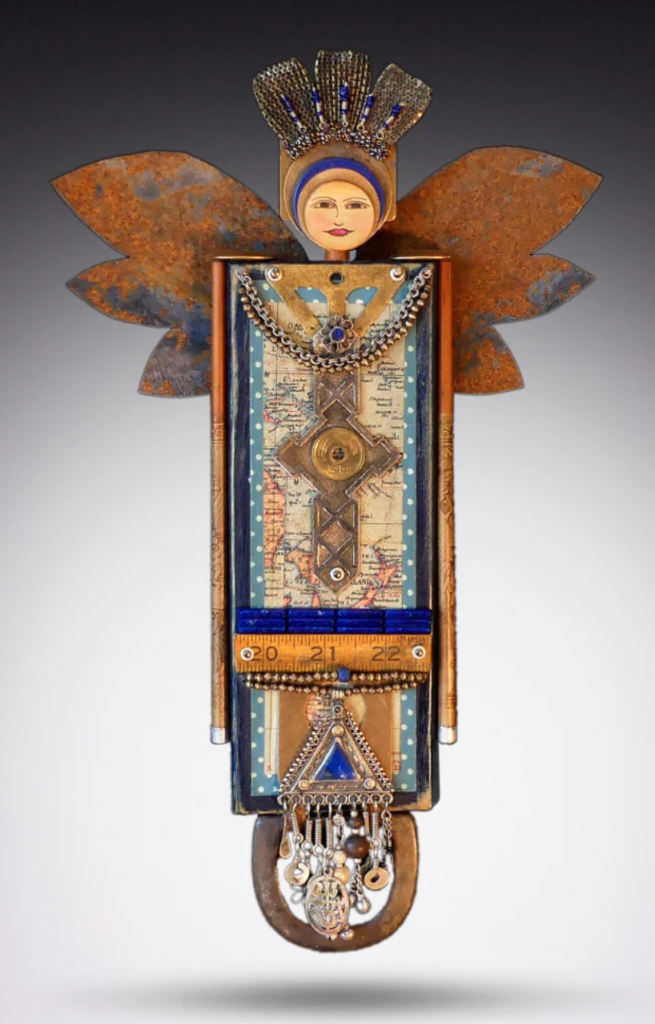
Mary Ennes Davis: I create “Guardians”, figures designed to hang on the wall, that I make using assembled, recycled materials. I use rusted metal turbine blades from an abandoned dam for their wings. I dig the blades out of a river bank in Oregon. The wood, paint, paper, fasteners, vintage hardware and parts are all reclaimed. Each comes with a thematic story that connects us to a community and to issues that are global. My studio, Crow River Studio, is in the watershed of Lake Whatcom and I am surrounded by conservation land, protecting the cities water source and the vegetation and animals that live here.

Leah Evans: An overarching theme in my quilts is the human impact on the environment. Effects of climate change addressed in my current work include species loss and displacement, changes in shorelines and subsequent effects on human and wildlife communities, and water conservation. Through handwork and a majority of repurposed materials, I create subtle reminders of how our actions can create both destruction and opportunity.

Amy Flynn: I work with recycled vintage objects that reflect a time when simple, discardable items like packaging tins and common household goods where well-designed and beautiful, unlike the those of our present plastic, throwaway culture. Each piece I source is soldered and bolted together to create a one-of-a-kind robot, thus creating futuristic objects from vintage parts.

Gatski Metal: Our work is handmade with reclaimed steel and barn wood. In sourcing our materials from scrap yards and junkyards, we are diverting them from the waste stream. We use these materials in their current state, thus avoiding further processing. Our simple handmade techniques require minimal use of fossil fuels. Many of our art pieces are inspired by the natural world around us. Our artwork is a nod to the importance of sustainability in our everyday life.

Galen Gibson-Cornell: My wall hangings are made from recycled materials using a process that promotes rethinking and reworking one’s surroundings to create meaning, rather than participating in cultures of manufacturing. The street posters with which I work also belong to a culture of wasteful production: thousands of paper advertisements created daily to be glued up to walls, and then discarded and thrown away. My goal is to examine these materials and the systems behind them by recycling and reusing them in a much more thoughtful and responsible way.
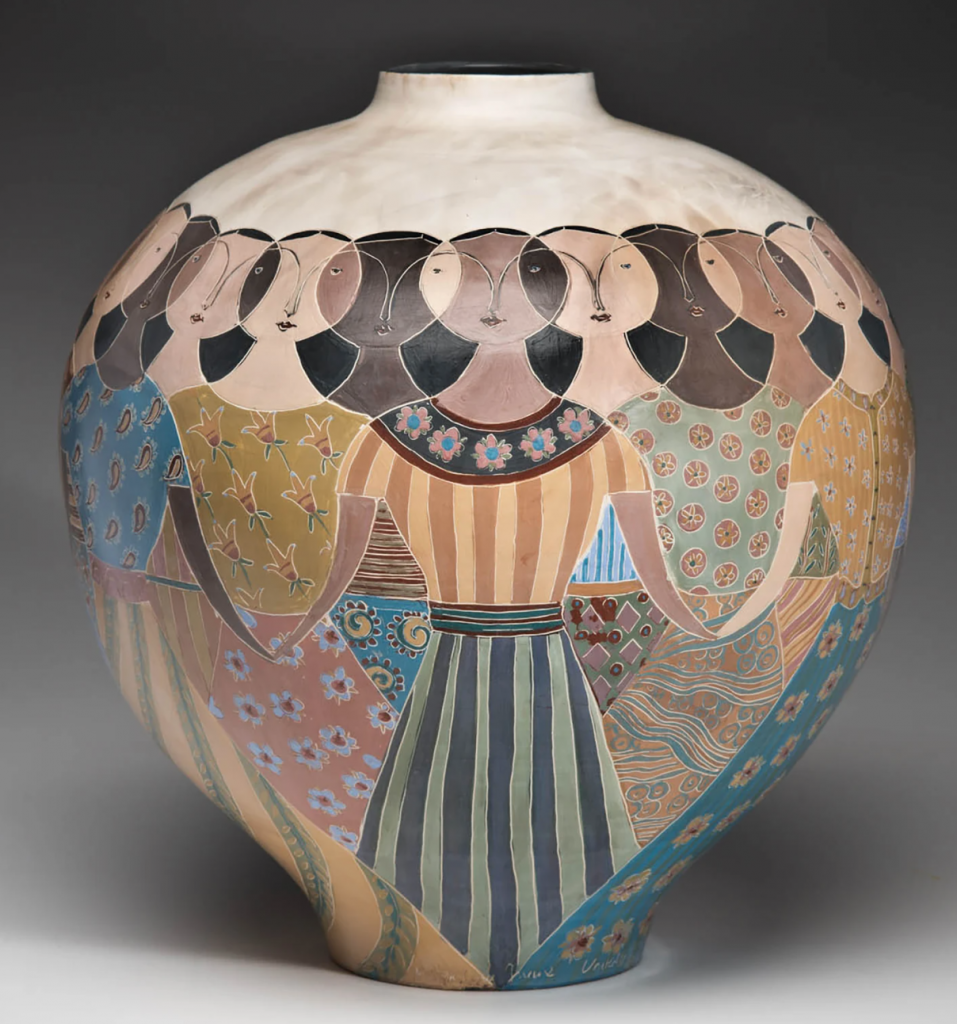
Melissa Greene: The animal imagery on my ceramics represents species that are endangered or whose environments which are in critical need of protection from pollution or habitat loss. The female imagery reflects the innate feminine attributes of joining together and nurturing, which strive to teach reverence for all living things and the natural world…essential for preserving all life and our planet.
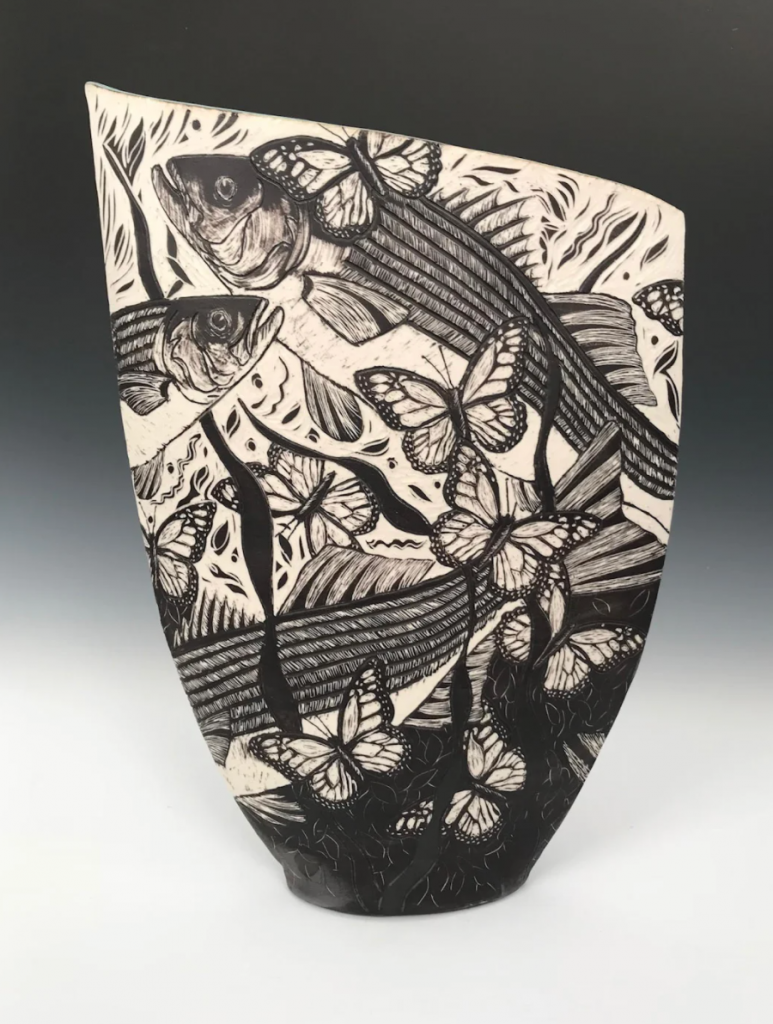
Shirley Gromen: My work is a portal into the everchanging natural world of the Chesapeake Bay watershed. Using sgraffito to interpret different species of birds, fish, insects and plants on functional and sculptural forms I hope to bring to the user/viewer an awareness and appreciation of the variety of interdependent life that surrounds us.

John Guertin/Barns Into Birdhouses: My birdhouses are made from repurposed century-old barns containing the remains of great forests that once ruled Michigan. My hope is to educate, to inspire reverence for these things once noble and have now become disposable, and to prove they have utility by creating from them new habitat for birds. The environment isn’t a throw-away. As stewards of the future, by sustaining world well-being and our fellow creatures, we shall sustain ourselves.

Andrea Haffner: My work invites people to embrace the small: to observe, appreciate, and cherish the abundant natural forms that grow in the world around us and might otherwise be overlooked. More than ever we need to honor and protect our environment. As the land surrounding my town was completely burned by fire three years ago, some of my work also addresses fire and regrowth in these times.
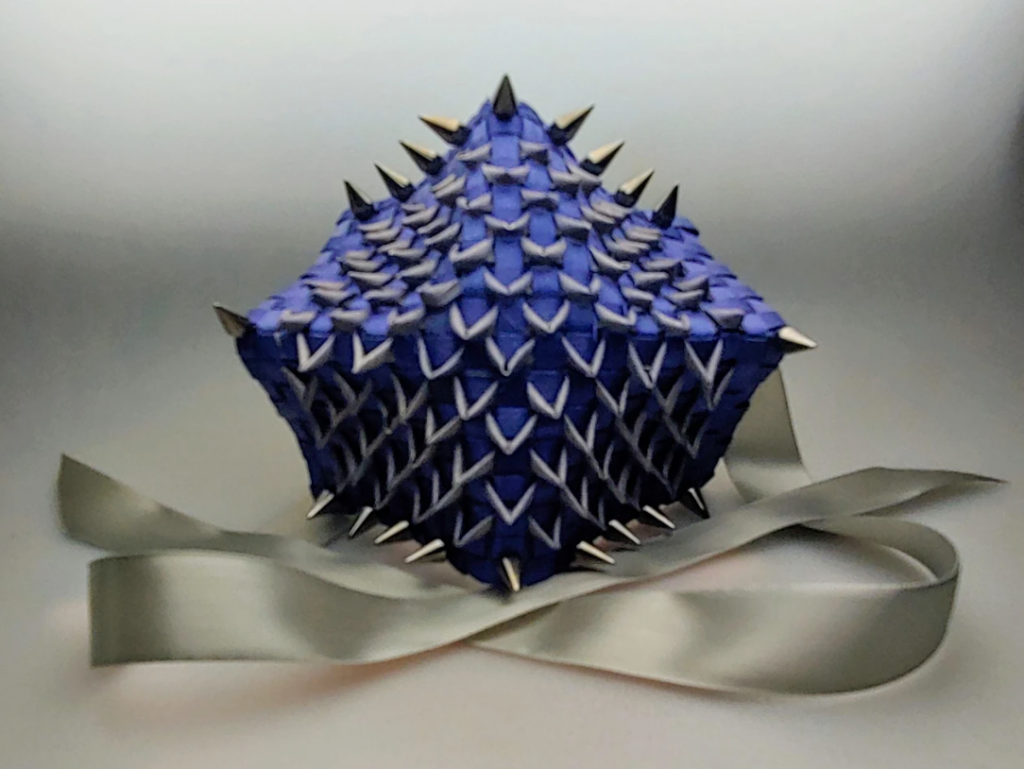
Carrie Hill, Chill Baskets: The black ash that we have used traditionally for weaving is currently being decimated by the emerald ash borer. My material is harvested and pounded by hand and them split or peeled apart to create the strips I weave with.

Nicholas Kekic: Three years ago I moved my glass studio to a building that uses the Connecticut river to generate its electricity so now my furnaces are running not on propane but on a green, renewable energy source.
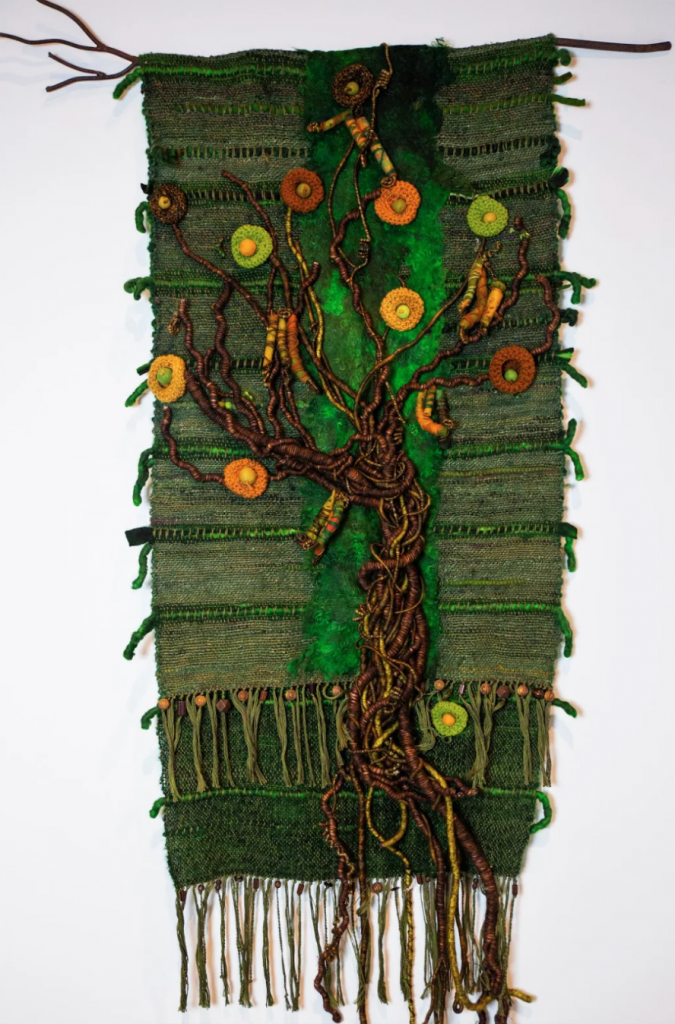
LaVerne Kemp: My work is inspired by my love of nature, particularly trees and how beautiful, interconnected, and majestic they are. Since childhood and throughout my artistic journey I’ve enjoyed sharing my creative visions of trees, using repurposed materials that I’ve over-dyed, spun, stitched, and woven while giving them new life. Repurposing a variety of found objects and rescued finds motivates my message of reinvestigating, re-engaging, and reconnecting with the world around us, both natural and human-made, with sensitivity and empathy. Through these practices, not only has my artwork allowed me to make beautiful sculptural wall pieces and items for the home but also wearable handwoven textiles such as shawls, scarves and ponchos using nature’s bold colors.

Kristy Kun: I am deeply moved by the transformative qualities of wool and plant fibers, which, when plied correctly, parallel environmental transformations; Birth, fruition, decay. Formations of water, earth and sky, emerge as if breathing and alive. My work tries to address the fragility of these relationships in nature and evoke a moment of genuine emotion relating to the human capacity to feel and preserve their poetic beauty.

Lenore Rae Lampi: The process in making my work includes purchased B Clay and use of recycled clay. The techniques include wheel throwing, extruding and hand building. Stain, glaze and terra sigillata are employed for the surface, many of which are made by recipe, not packaged. The process in this series includes found pieces of birch as inspiration. Found Furls was the title of a series which has since evolved. Climate change has devastated the birch trees in Northern Minnesota, my work is in homage to this, the “giving tree”.
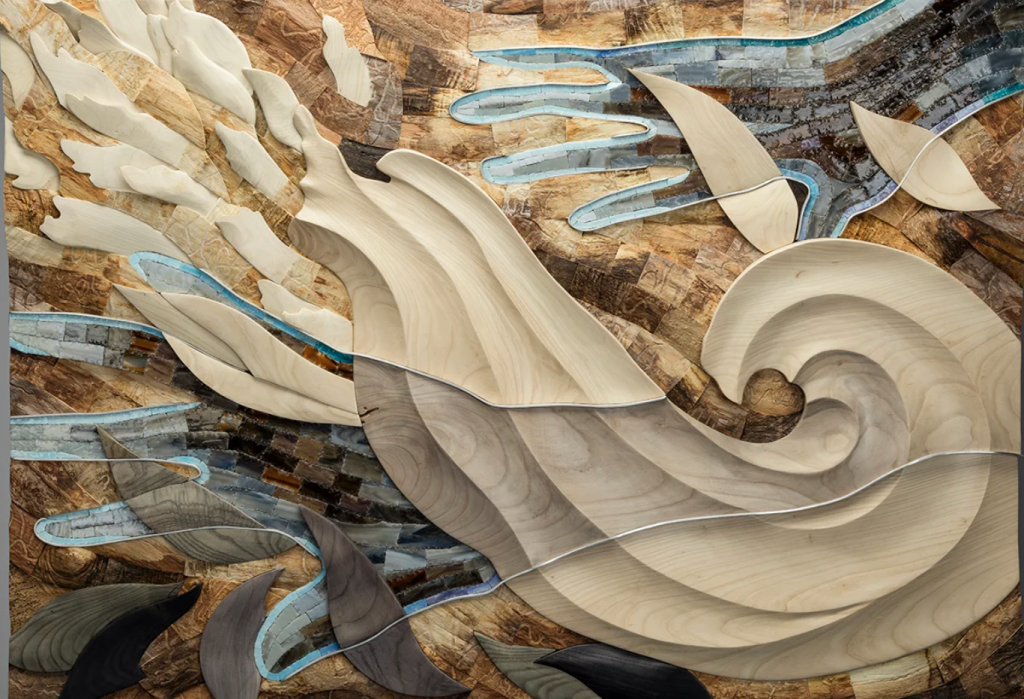
Aaron Laux: My wall hangings are made from reclaimed materials and local woods that are renewable. Waste wood materials from my work are used as substrate for growing edible mushrooms. Themes of connection to nature and the healing aspects of that connection are ever present in the work. Focus on the personal stories of that connection, how emotional and spiritual healing creates space for a loving, reciprocal relationship with nature. Recent exhibitions have specifically dealt with climate change and related issues. Including the “Phoenix from the ashes”, that brought attention to the emerald ash borer crisis. As well as “Swept Away” focused on aspects of climate change.

Jennifer McBrien: I am a fiber artist, who uses freehand-machine and hand embroidery with appliqué techniques on found, vintage, and certified organic fabrics to make my narrative wall hangings, decor pillows and handbags. I make ecological choices to keep my work sustainable with small batch, high quality and eco-friendly production. My work honors endangered and ignored birds and plants.

Rowland and Chinami Ricketts: We use natural materials and traditional processes to create contemporary textiles. Chinami hand-weaves narrow width yardage for kimono and obi. Rowland hand-dyes textiles that span art and design. Together we grow and process our own indigo (Persicaria tinctoria) using Japanese methods that are centuries old. The leaves are harvested, dried, and composted by hand to make the traditional Japanese indigo dyestuff called sukumo. The sukumo is in turn fermented in wood-ash lye to create a natural indigo vat. In addition to the color they create, these living vats provide nutrients for our land that are recycled back onto our indigo field at the end of their lifespan. Similarly, the rainwater used for rinsing is captured and used to water our garden and indigo plants, so that at the end of the dyeing process the only thing leaving our land is the color itself on the textiles we create.
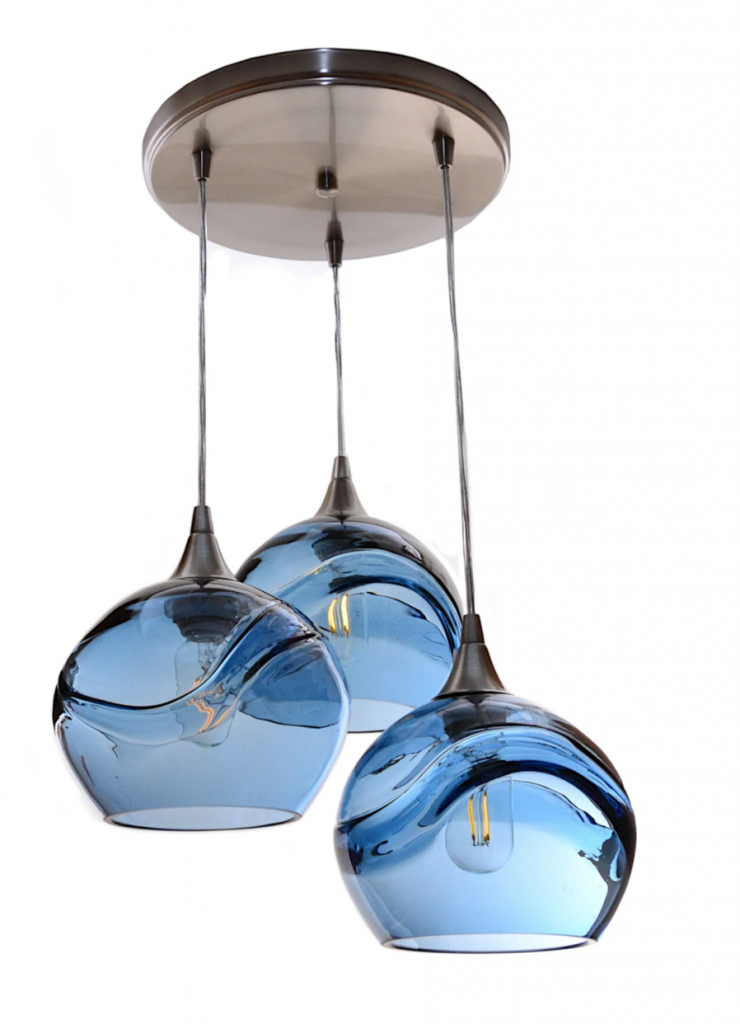
Bicycle Glass Co.: Our products promote the use of recycled material to offset the energy of glass production. Using 100% post-consumer recycled glass and our own internal recycling systems, we take pride in sharing that our work offsets as much waste as possible. From packaging to product, Bicycle Glass is looking to make artisan glasswork without the environmental impact.

Colin Selig: I create eco-friendly outdoor seating and biomorphic sculpture repurposed from scrap steel propane tanks. My patented process has a minimal carbon footprint and produces durable objects that contain 99% post-consumer reused content. I have completed numerous public art commissions across the US which I hope will inspire others to consider new possibilities for reusing materials.

Eric Serritella: Through aging and decay, I explore how nature maintains its splendors with tenacity and triumphs of existence, despite human disregard. Ceramic creations mirror the environment—easily damaged if disrespected and yet invincible in its inherent beauty and longevity. Each artwork fosters awareness as viewers acquire new appreciations and ways of seeing and can thus choose to walk with softer steps.
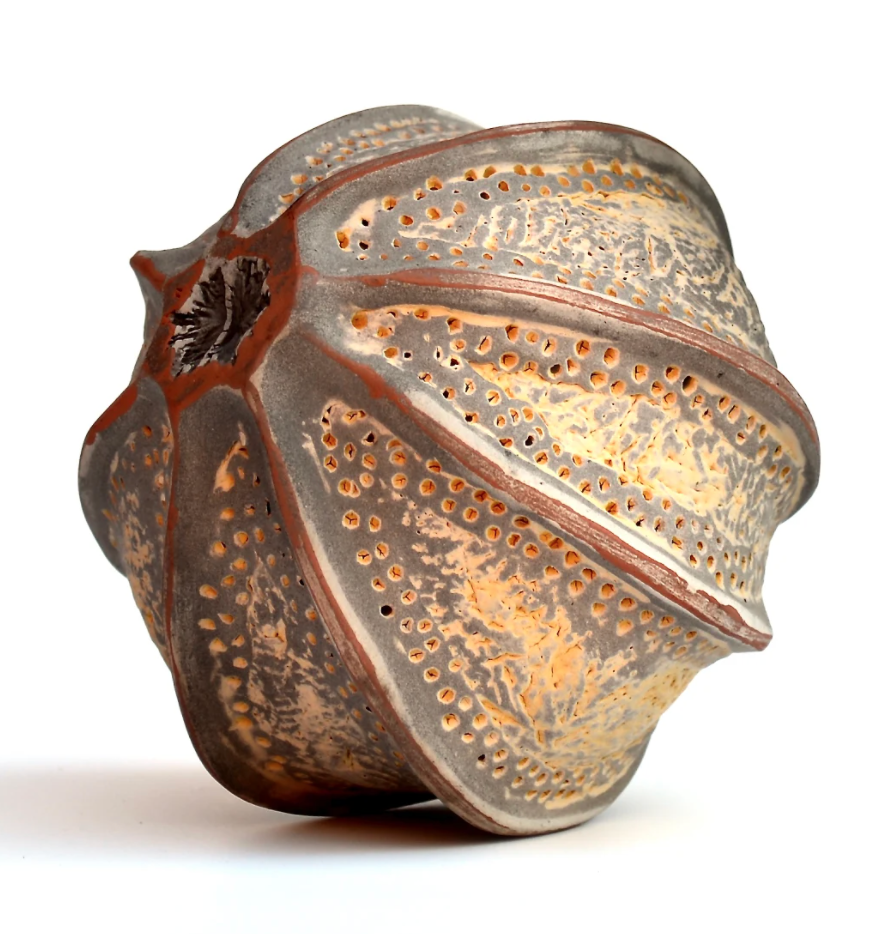
Paula Shalan: I respect our earth’s limited resources by employing traditional methods of hand-building, using local clay and firing with recycled fuel. My detailed seedpods express the importance of biodiversity for the health of our forests. Each seedpod conveys hope as it lays dormant waiting to burst forth with its unique contribution to a healthy ecosystem.
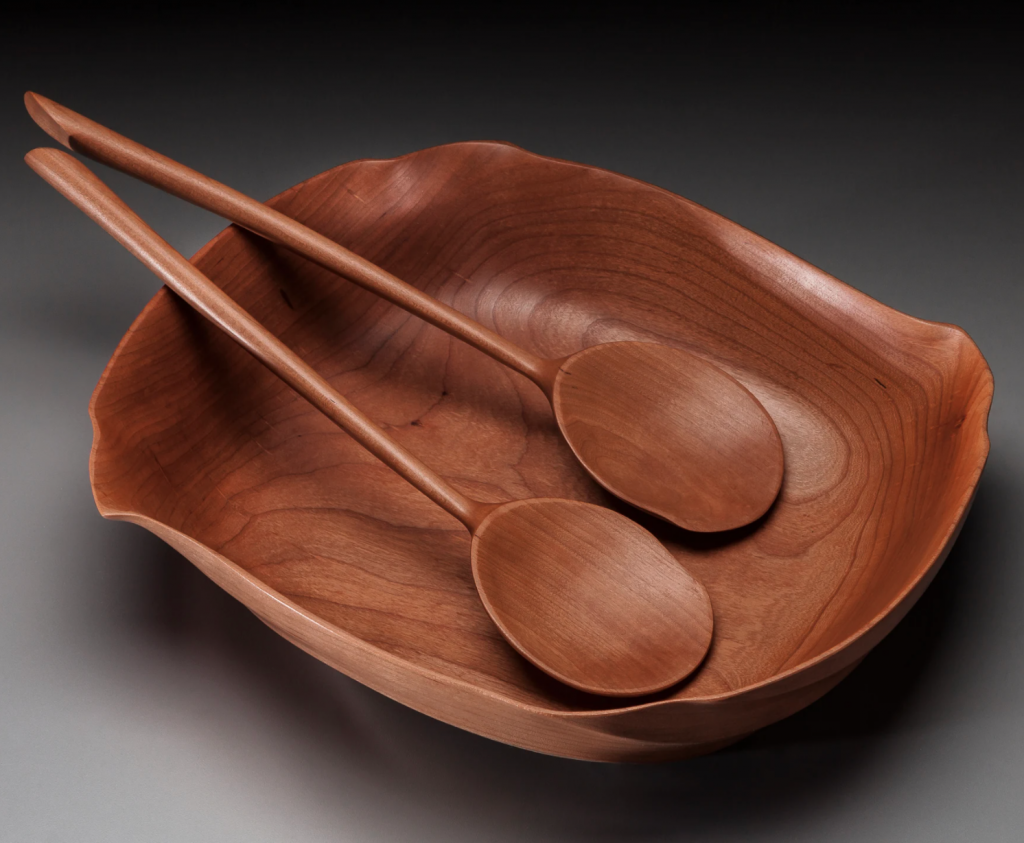
Holly Tornheim: All my work is created in a solar-powered studio. The wood I use includes leftover pieces from furniture makers and also material from local brush clearing. All the non-domestic wood I use is either Forest Stewardship Council certified or remnants given to me by other woodworkers. All scraps remaining are burned for heat in my home.

Denny Wainscott: I work with gourds which are renewable each year. I crush turquoise, lapis and malachite for my inlay. Gourds need 120–130 days without frost to mature. As the gourd plant matures, the leaves get very large. As the plants get larger the leaves will keep the moisture under the leaves. Hard shelled gourds have white flowers that only open in late evening or night. They are pollinated by cucumber beetles or moths.The growing season is important.
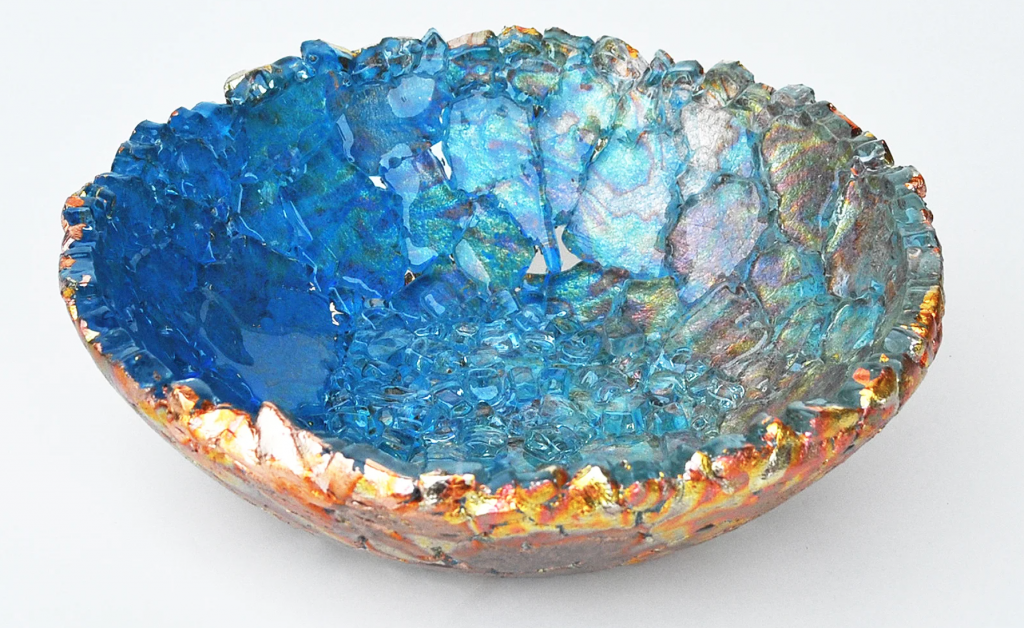
Mira Woodworth: Glass does not break down in a land fill. Unfortunately, when tempered glass such as glass shelves have been used, their owners cannot put them in a recycle bin. They cannot be cut down. They are often scratched and not re-usable. I reclaim this glass and remake it into the artwork that you see. This keeps this non-biodegradable materials out of landfills.

Christina Boy: Though my work may not always portray it, all my wood waste gets recycled- sawdust goes into our garden, small scraps get used for kindling, and once a year usable scrap gets turned into small household items. My sole water source in the studio are rain barrels. My paints are organic and water based, and the finishes for wood are ecologically conscious.

Phil Gautreau Wood Design: My specialty is in hand-turned wood vessels and wooden serveware often made from locally-sourced, repurposed wood from locations including Brooklyn Botanic Garden, BUILD IT GREEN (repurposed materials store) and public and private venues near my Brooklyn-based studio. Substantial amounts of excess wood from local furniture builders also used. I create contemporary wood accessories made with highly figured, visually unique wood draped over clean designs.

A Good Catch: I create linen towels and beeswax wraps to reduce plastic usage and encourage the reduction of paper waste. Printing is locally sourced, using eco-friendly pigment inks free of chemicals and conserves water. I print my art onto ethically sourced fabric making it functional.
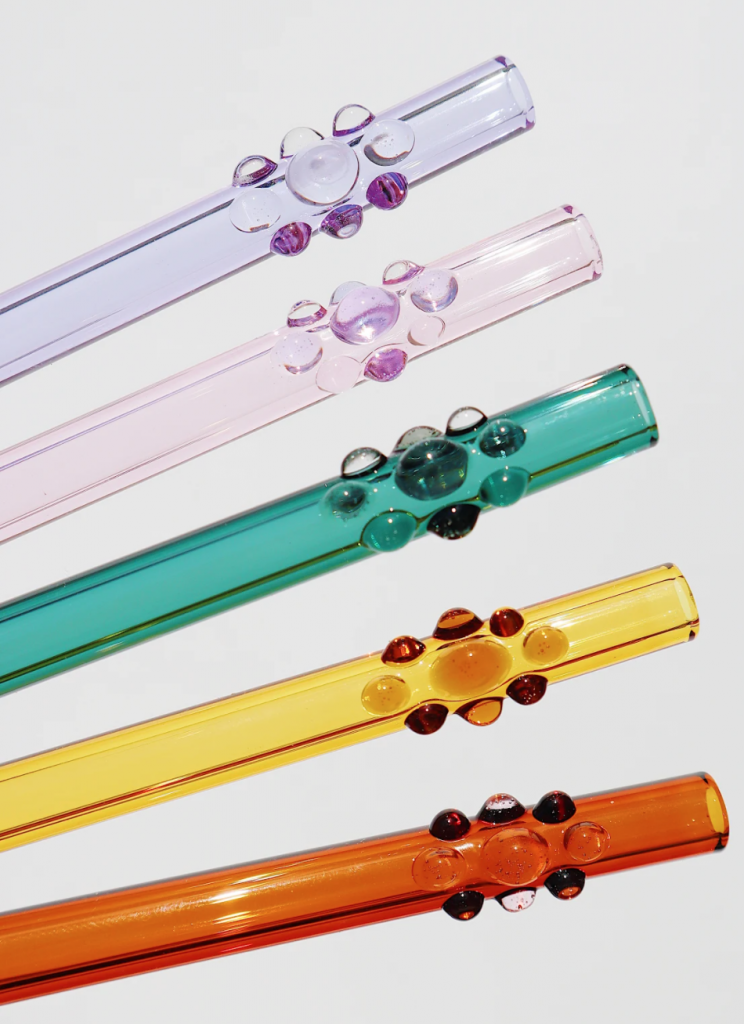
Arlie Glass: My hope is that my glass straws inspire people to reduce single use plastic in their lives. I live and work in my home glass studio on the island of Oahu, Hawaii. Pieces of plastic from all over the world make their way on to our beaches. We do our best to coordinate clean ups and keep the waste from being pulled back into the water with the next tide – but it is a small fraction of the amount of trash found all throughout the ocean. In the grand scheme of things, plastic straws are a small part of the problem but eliminating them is one of the simple first steps many people can take.

Blue Skies Workroom/Alyssa Salomon: I screen print with eco-friendly, water-based inks and utilize non-toxic cyanotype photographic printing on plant-fiber materials. All fabrication is planned to minimize waste; offcuts are collected for use by a papermaker. Two series of totebags – Joy and Spinner – are made by printing on antique linen yardage and lined with vintage fabric leftovers donated by fellow textile workers.

Shaker Sawdust Co.: The Shaker design uses a minimal amount of materials. Just four pieces of wood can be used to make a box. My methods address resource conservation.

malagueta: Since 2015, the fabric remnants that would otherwise be thrown out are being pieced together to make tops, skirts, accessories, and home goods. The intention behind this new line of items is to keep my fabric waste to an absolute minimum as to not contribute to the already increased fabric waste being created by the global fashion industry.

Topaz M. Terry: There is no away. Trash does not magically disappear from the face of the Earth when we discard it. My work makes bicycle waste (the parts that wear with normal use) a raw material. Instead of sending those parts to landfill, I make them valuable again, turning them into durable and wearable accessories for everyday use.

Jennifer Wilfong: As a ceramicist, having a private study seems ideal. However, the energy that it takes to fire kilns and run an independent studio, when there was a collective studio near me, did not seem like an environmentally sound choice for me. Instead of firing half empty kilns and duplicating the resources, I’ve chosen to work in a collective/shared space with 50 studio mates. The clay I use comes from Pittsburgh and is delivered locally to Baltimore Clayworks Supplies, which I love, because that means the clay is shipped in large quantities versus many small deliveries. All of the clay I use gets recycled and reclaimed, either by me or my studio mates. I use recycled packing materials whenever possible and have a supply of previously used packing materials that my neighbors supply me with regularly.




